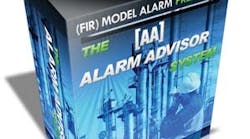Wouldn't it be nice to beat some of those pesky alarms to the punch? Well, using advanced process control (APC) and simulation to optimize applications is fine, but it would be even better if you could use faster, closer to real-time simulations to predict and respond to alarms before they happen. That's the strategy behind Alarm Advisor (AA) from Cutler Technology Corp. (CTC) in Boerne, Texas. AA is an upcoming capability that's being added to CTC's Operator Advisor (OA) software, which itself is part of the firm's CTC Sim process simulator and Max APC controller.
Charlie Cutler, CTC's president, and Matthew Hetzel, CTC's software development VP, came up with OA and AA several years ago when they realized how fast CTC Sim was running its scenarios. "After putting the all-valve version of the APC model in the simulator, we noticed it was running 150 to 200 times faster than the real-time process," says Cutler. "As a result, users could see in a few minutes what it would take hours for the process unit to show, and this meant the APC model in our simulator was able to predict alarms. This could give operators close to real-time advice on alarms. They could ask what would happen if a controller was in manual and they moved a valve, and the simulator would show the whole path—including alarms placed on dependent variables."
"PID controllers are common in all process plants, and they use setpoints to move valves. Traditional simulators are slow because they must integrate PID dynamics with the mathematical description of the process," he says. "Also, while most simulators seek to solve non-linear differential equations, we linearize them and solve a set of linear differential equations. This allows simpler calculations, which is why we can do them approximately 100 times faster."
Cutler adds that CTC's approach with AA and OA is a quantum leap for process simulation because typical PID controllers run independently, so users can't take APC models and put them into simulations. "So we came up with a way to remove the PID dynamics, but leave the basic process dynamics intact," explains Cutler. "We say, ‘If a linear model is good enough to run a plant, then it's also good enough to simulate it.' In our FIR model, we optimally match and fit data to the user's process. However, even though our simulator only costs about half as much to build and maintain, there's a whole industry built on complex simulators, and so there's a lot of resistance to our solution."
The main advantage of CTC's Alarm Advisor is that, instead of users employing OA to run "what if" scenarios manually, AA will do it automatically by reading current values every few minutes, running a simulation for the next several hours, and then displaying expected alarms. In fact, Hetzel adds that AA will give operators the predictive capability of CTC's Max APC controller when they're running manually.
"OA tells operators the result of process changes. For example, if they want to add 1000 barrels of feedstock, OA will automatically report what's going to happen to their application, and tell them if what they're planning will put their unit in an alarm situation," adds Cutler. "AA will identify and display future alarms by type and what time they're going to happen. This will let operators adjust their process ahead of time to prevent alarms that would otherwise have been a surprise, and so minimize disturbances, avoid running off spec and more easily optimize their process."
For more information, call Cutler Technology at 210/525-8701, email [email protected] or visit http://www.cutler-tech.com/.




